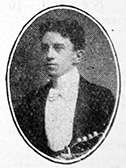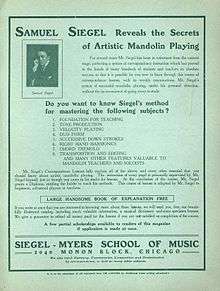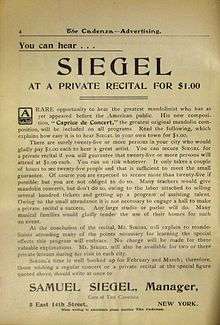Samuel Siegel

Samuel Siegel (born 1875, Des Moines, Iowa — died January 14, 1948, Los Angeles, California) was an American mandolin virtuoso and composer who played mandolin on 29 records for Victor Records, including 9 pieces of his own composition and two that he arranged.[1][2][3][4][5] Siegel was the first mandolinist to record on Emile Berliner's phonograph disk-records.[4] He was labeled "America's Greatest Mandoline Virtuoso" and "The King of the Mandolin" in the May 1900 Banjo World.[4]
Siegel performed both in Vaudville, as well as in concert halls.[4] He had no formal training in music, but saw that the mandolin needed original music, rather than relying on the transcribed violin music.[4] His compositions and arrangements were well known in his day.[4]
He was the author of Siegel's Special Mandolin Studies, published by Jos. W Stern and Company, 1901, in which he covered left hand Pizzicato and harmonic duo style.[6][7]
Recording partners
Siegel recorded with Roy Butin in 1908 on four Victor records, the tunes: Southern Fantasy, Estellita Waltz, American Valor March, and In Fairyland.[8]
 |
Samuel Siegel and Roy Butin play Gavotte.
A 1909 Edison Amberol recording of Samuel Siegel on mandolin and Roy Butin on guitar. |
| Problems playing this file? See media help. | |
He recorded Edison Diamond Disk record Ragtime Echoes in 1918 with Marie Caveny, with her on ukulele, and also Dance, Mouse Dance, and Medley.[9][10] Marie and her husband James Frank Caveny lived with Siegel as lodgers in Chicago during the 1910 United State Census.[11] They were performers or lecturers in the Lyceum movement.[12] James Franklin was a cartoonist and she sang soprano in their performance.[12]
 |
Samuel Siegel and Marie Caveny play Ragtime Echoes, one of Siegel's compositions, recorded on an Edison Diamond Disk record.
A 1918 recording with Samuel Siegel on mandolin and Marie Caveny on ukulele. |
| Problems playing this file? See media help. | |
Victor recordings


Recorded for Victor records between October 20, 1900 and December 28, 1918.[1]
- The foxhunters two-step
- Espagnole waltz
- Hawthorne club
- Remembrance of thee
- Medley of coon songs
- Ma lady Lou
- Volunteer patrol
- American valor march
- La bonita waltz
- Romance
- In olden times
- Nearer my God to thee
- Manzanillo
- An autumn evening
- A-sa-ma
- Maritana mazurka
- Navajo medley
- La cinquantaine
- Träumerei
- Intermezzo
- The whirlwind march
- Boston Ideal march
- Estellita waltz
- American valor march
- In Fairyland
- Medley, (December 28, 1918) with Marie Caveny (ukulele)
- Dance, (December 28, 1918) with Marie Caveny (ukulele)
- Ragtime echoes, (December 28, 1918) with Marie Caveny (ukulele)
- Mouse dance, (December 28, 1918) with Marie Caveny (ukulele)
Columbia Records
He made records for Columbia Records.[13]
- La bonita waltz (1901), Samuel Siegel (mandolin)
- Zenda waltz (1901), Samuel Siegel (mandolin)
- Hawthorne Club (c 1904-1909), Samuel Siegel (mandolin)
- Ivanhoe Intermezzo with Geo. Stehl & Hans Von Wegern
- Mazurka Brillante
Edison recordings
He recorded for Edison Records on their Blue Amberol, Gold Moulded, and Diamond Disk albums.[10][13]
Gold Molded
- Home, sweet home (1902), Samuel Siegel (mandolin)
- Manzanilo (c. 1902), Samuel Siegel (mandolin)
- The story teller waltz (1903), Samuel Siegel (mandolin)
- My Old Kentucky Home (1903), Samuel Siegel (mandolin)
- Just One Girl (1904), Samuel Siegel (mandolin)[14](Music written by Lynn Udall, 1898)
- An autumn evening (1905), Samuel Siegel (mandolin) and M. Loyd Wolf (guitar)
- Evening on the plaza (1905), Samuel Siegel (mandolin)
Blue Amberol
- Castilian Echoes (1908), Samuel Siegel (mandolin) and William Smith (guitar)
- Waltz (1909), Samuel Siegel (mandolin) and Roy H. Butin (guitar)
- Gavotte (1909), Samuel Siegel (mandolin) and Roy H. Butin (guitar)
- Waltz (1913), Samuel Siegel (mandolin) and Roy H. Butin (guitar)
- Kuu ipo i ka hee pue one medley (1919), Samuel Siegel (mandolin) and Marie Caveny (ululele)
Diamond
- Ragtime Echoes (1918), Samuel Siegel (mandolin) and Marie Caveny (ukulele)
Indestructible Records
He made records marketed by Indestructible Records.[13]
- Estellita waltz (1908), Samuel Siegel (mandolin) and Roy Butin (guitar)
- Southern fantasie (1908), Samuel Siegel (mandolin) and Roy Butin (guitar)
See also
References

- 1 2 Victor: Encylopedic Disography of Victor Recordings. "Samuel Siegel (instrumentalist : mandolin)". Retrieved 2014-07-07.
- ↑ Victor: Encylopedic Disography of Victor Recordings. "Samuel Siegel (composer)". Retrieved 2014-07-07.
- ↑ Victor: Encylopedic Disography of Victor Recordings. "Samuel Siegel (arranger)". Retrieved 2014-07-07.
- 1 2 3 4 5 6 Sparks, Paul (1995). The Classical Mandolin. Oxford: Oxford University Press. pp. 123–125, 223. ISBN 978-0-19-517337-6.
- ↑ J. Garber. "Rootsweb, Siegel-L-SamuelSamuel". Retrieved 2014-07-08.
- ↑ Mair, Marilynn (2011). Complete Mandolinist. Mel Bay Publications. p. 4.
- ↑ Dalton, Jim (2006). Duo Style Mandolin (PDF). Sining String Music Publications. p. 3.
- ↑ Gregg Miner. "Roy Butin, Revealed!". Retrieved 2014-07-20.
- ↑ Victor Records, Encyclopedic Discography of Victor Recordings, Miss M. Caveny (instrumentalist : ukulele)
- 1 2 National Park Service, Thomas Edison National Historic Park, New Jersey, Popular Instrumental, Ragtime
- ↑ United States Census, Year: 1910; Census Place: Chicago Ward 25, Cook, Illinois; Roll: T624_268; Page: 3A; Enumeration District: 1057; FHL microfilm: 1374281
- 1 2 The Lyceumite Art and Talent, Their Art Appeals to Eye and Ear, Why J. Franklin Caveny Has Been Thirteen Years on the Platform and How Mrs. Caveny Completes the Pictures. A Glimpse of Two Artists in the Art of "Making Good"
- 1 2 3 Cylinder Preservation and Digitization Project, Department of Special Collections, Donald C. Davidson Library, University of California, Santa Barbara
- ↑ YouTube video of Just One Girl by Samuel Siegel, showing the recording case and label.
External links
- Works by Samuel Siegel at Project Gutenberg
- Works by or about Samuel Siegel at Internet Archive
- Library of Congress record listing digitized recordings in their collection by Siegel
- Library of Congress record and online stream of Navajo Medley, arranged and played by Siegel.
- Library of Congress record for a recording Siegel made of his arrangement of Nearer My God to Thee.
- Mandolin Cafe thread with pictures of a program of music in which Siegel played.
- Cylinder preservation and Digitization Project, University of California, has digitized Siegel public-domain recordings and made available to download.
- Advertisement for Siegel's mandolin method.
- Mandotopia page, has links to public domain book of mandolin music, arranged by Siegel.
- Picture of a recital program cover for Samuel Siegel.
- Website for a mandolin teacher which contains one page of Siegel's method book.
- Endorsement by Samuel Siegel of Regal mandolins. Page also has details of one of his transcontinental tours.
- Advertisement for Siegel's music school, the Siegel-Myers School of Music.